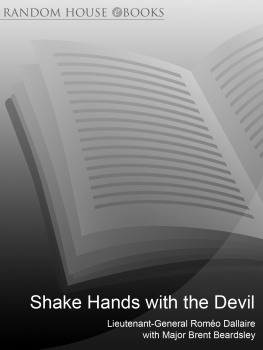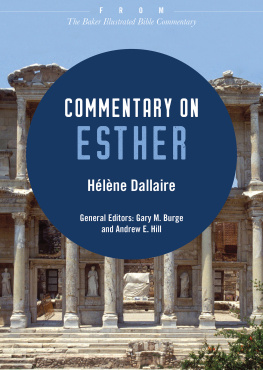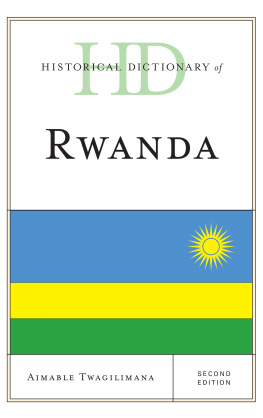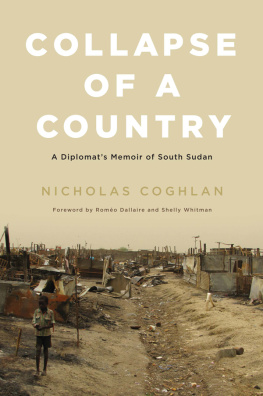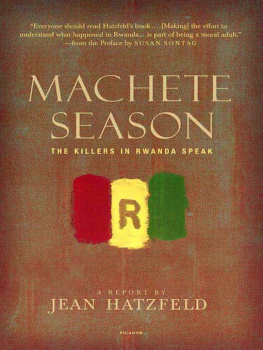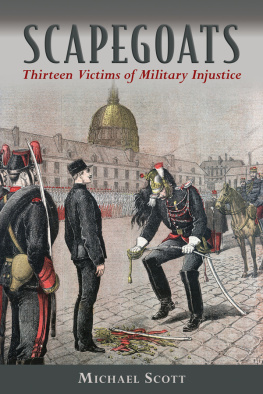CONTENTS
About the Book
When Lt. General Romo Dallaire received the call to serve as force commander of the UN mission to Rwanda, he thought he was heading off to Africa to help two warring parties achieve a peace both sides wanted. Instead, he and members of his small international force were caught up in a vortex of civil war and genocide. Dallaire left Rwanda a broken man, disillusioned, suicidal, and determined to tell his story.
An award-winning international sensation, Shake Hands with the Devil is a landmark contribution to the literature of war: a remarkable tale of a soldiers courage and an unforgettable parable of good and evil. It is also a stinging indictment of the petty bureaucrats who refused to give Dallaire the men and the operational freedom he needed to stop the killing. I know there is a God, Dallaire writes, because in Rwanda I shook hands with the devil. I have seen him, I have smelled him and I have touched him. I know the devil exists and therefore I know there is a God.
About the Author
Lt. General Romo Dallaire served as force commander of the UN Assistance Mission for Rwanda from July 1993 to September 1994. Shake Hands with the Devil, his eyewitness account of the Rwandan genocide, won the Shaughnessy Cohen Award and the Governor General Award.
CONCLUSION
In the introduction to this book I told the story of meeting a three-year-old orphan on a road lined with huts filled with the Rwandan dead. I still think of that little boy, who if he lived would be a teenager as I write. What has happened to him, and the tens of thousands of other orphans of the genocide? Did he survive? Was he reunited with any members of his family, or was he raised in one of Rwandas overcrowded orphanages? Did anyone care for him and love him for himself, or was he raised with hate and anger defining his young life? Did he find it in himself to forgive the perpetrators of the genocide? Or did he fall prey to ethnic hate propaganda and the desire for retribution and take his part in perpetuating the cycle of violence? Did he become yet another child soldier in the regions wars?
When I think about the consequences of the Rwandan genocide, I think first of all of those who died an agonizing death from machete wounds inside the hundreds of sweltering churches, chapels and missions where theyd gone to seek Gods protection and ended instead in the arms of Lucifer. I think of the more than 300,000 children who were killed, and of those children who became killers in a perversion of any cultures idea of childhood. Then I think of the children who survived, orphaned by the genocide and the ongoing conflict in the regionsince 1994, they have been effectively abandoned by us as we abandoned their parents in the killing fields of Rwanda.
When we remember the Rwandan genocide, we also have to recognize the living hell these children inherited. My work after the genocide has intimately acquainted me with the circumstances in which the children of genocide and civil war are forced to survive. In December 2001, as part of my duties as special adviser on war-affected children to the minister responsible for CIDA , I conducted a field visit to Sierra Leone to get first-hand information on the demobilization and reintegration of child soldiers and bush wiveschildren who had been abducted from their families and had then fought for several years as part of the once powerful rebel force, the Revolutionary United Front ( RUF ). I travelled deep into the heart of rebel territory, near the towns of Kailahun and Daru in the far eastern sector of the country. I remember a visit that my small team, which included retired Major Phil Lancaster, made to the local demobilization centre. Sitting down with a group of the boys, all around thirteen years of age, we were soon discussing tactics, bush life and the brutality of civil war. They were only a few days into the retraining process, and they fervently hopednow that they were permitted to hopethat they had a promising future in a country that could sustain peace. But, talking with them, it was clear that if things did not work out in the camp, they would return to the free and violent life of terrorism in the bush, where they would carry on taking what they wanted by force. The rehabilitation and reintegration period was scheduled to last at best three months, and they wanted to know what would happen next. Who would pick up the ball? Certainly not their families or communities, who had yet to accept them back, nor their devastated country in which teachers and other educated persons and potential leaders had been a favourite assassination target. Abducted at nine or even younger, a number of these boys had become RUF platoon commanders, and in terms of experience they were thirteen going on twenty-five; if laying down their weapons meant they had no future except to join thousands of others in displaced and refugee camps that dotted the countryside, they would not countenance it. Some of them were running camps within the camps for the younger children; if these combat-tested leaders were not specifically targeted for advanced education and social development programs, they would surely lead the children back into the bush. Simple, well-intentioned Dick-and-Jane schooling was not going to be enough to meet their needs.
Even worse off were the girls, who were much shyer about coming forward for help. Many of them had serious medical problems caused by rape, early child-bearing and unassisted births. Their state of health was appalling. A high proportion had been infected with HIV / AID s by the male adults in the rebel army, and were so emotionally scarred and so inexperienced with normal life that it was difficult for them to care properly for their children. Where would they find the necessary love to give their babies when they could not remember ever having received it themselves? In time, the boys were generally accepted back into the community, but the girls were often shunned and abandoned, since in this male-dominated culture they were considered to have been permanently sullied by the uses to which the soldiers had put them. If they tried to go home, they and their children became outcasts in their communities; if they went to the displaced and refugee camps, they again became the prey of adult males. Some of the girls had fought or held considerable responsibilities in the rebel formations; if properly supported, there was a chance they could become leadersthe forerunners of change on the gender-equality front. The demobilization and reintegration camps were their best chance, which was nearly no chance at all, especially if the aid community didnt get behind them and help.
This was the fate that may have awaited the boy on the Rwandan road, the fate all the children of the Rwandan genocide would have been lucky to avoid. These disordered, violent and throwaway young livesand the consequences of the waste of these lives on their homelands, and inevitably on the rest of the worldare the best argument to vigorously act to prevent future Rwandas.
Too many parties have focused on pointing the finger at others, beyond the perpetrators, as the scapegoats for our common failure in Rwanda. Some say that the example of Rwanda proves that the UN is an irrelevant, corrupt, decadent institution that has outlived its usefulness or even its ability to conduct conflict resolution. Others have blamed the Permanent Five of the Security Council, especially the United States and France, for failing to see beyond their own national self-interest to lead or even support international intervention to stop the genocide. Some have blamed the media for not telling the story, the NGO s for not reacting quickly and effectively enough, the peacekeepers for not showing more resolve, and myself for failing in my mission. When I began this book, I was tempted to make it an anatomy of my personal failures, which I was finally persuaded would be missing the point.
Next page
